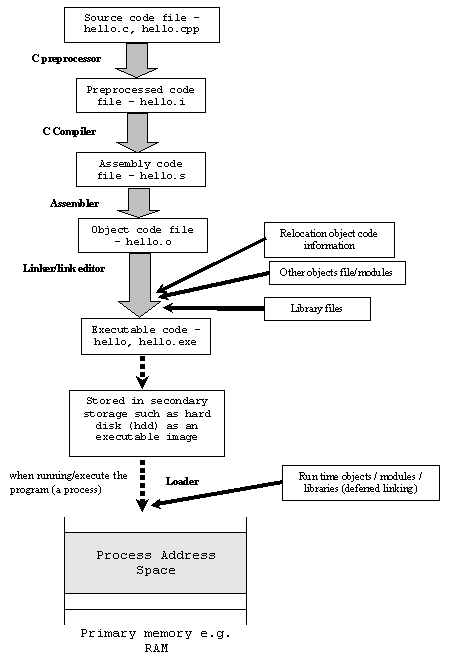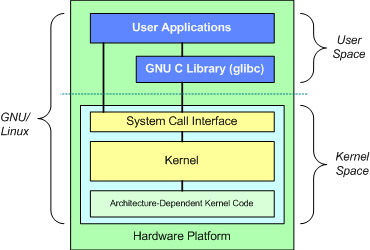(2) System Tools
COP-3402, Spring 2024
Table of Contents
Overview
- Great programmers know their tools
- Command-line exposes powerful, fast tools
- We'll cover
- Basic shell commands
- Navigating the file system
- Processes
- Useful utilities
- git
- gcc
- make
Command-line crash course
- Follow along with vagrant
Command-line basics
cd ~/ pwd ls ls -l ls -latrh cd cd /vagrant cd ~/ cat echo echo "hello world" > newfile.txt cat newfile.txt echo "hello world" | cat tac newfile.txt less newfile.txt # q to quit
More basics
mkdir newdir touch emptyfile.txt cd newdir pwd ls cd ../ cd ~/ rmdir newdir rm newdir/empty rmdir newdir mkdir targetdir cp emptyfile.txt targetdir ls -R ls targetdir/ touch filetomove.txt mv filetomove.txt targetdir ls -R cd targetdir mv filetomove.txt ../ cd ../ ls -R
Tab-completion
ls <tab><tab>n<tab> touch none.txt ls <tab><tab>n<tab><tab>o<tab>
Directory hierarchy
tree # to show hierarchy ls /<tab><tab>v<tab><tab> pwd cd subdir # absolute vs relative paths cd ../ # parent dir cd ./ # current dir ls ./ # current dir cat ./newfile.txt # same as cat newfile.txt ls -la
Standard I/O and redirection
ls > lsoutput.txt gcc -o printer printer.c # fprintf(stdout/stderr) ./printer > out # ./printer 1> out ./printer 2> err ./printer > out 2> err ./print >out 2>&1
Pipes
- Redirections stdio between processes (instead of just files)
cat file cat file | grep "hello" cat file | grep "hello" | cut c2-
Processes
ps ps -aux ps -aux | grep paul ls top htop echo $?
Useful tools
man
man cat man atoi man -a exec
find
grep
tar
tar -cvf packagename.tar file1 file2 tar -tvf packagename.tar tar -xvf packagename.tar
editors
- nano, emacs, vim
diff
- Show differences between text files
od
- Show raw bytes of a file
wget and curl
dos2unix and unix2dos
git tutorial
Setup
Enter your virtual machine, which should have been setup according to these instructions
cd cop3402spring24 vagrant ssh
Create the ssh key
ssh-keygen -b 4096 # can just hit enter a few times for an empty password, but generally adding a password is a good idea
View your public key (be sure to have the
.pubextension or you will reveal your private key!)cat ~/.ssh/id_rsa.pub # .pub is important!
- Add your public key to github according to their directions
Configure git with your name and email, replacing "Your Name" with your name and "youremail@yourdomain.com" with your the email address you use for GitHub.
git config --global user.name "Your Name" git config --global user.email "youremail@yourdomain.com"
Add the key to your ssh key manager (optional, but avoids prompt for ssh key password)
eval $(keychain --eval) # add to keychain ssh-add ~/.ssh/id_rsa
If
keychainfails to run, then be sure your virtual machine has been provisionedClone your repository into the mapped vagrant folder
cd /vagrant
Clone your repository (replacing USERNAME with your GitHub user name). If this is your first time connecting with GitHub, it will ask you to confirm that server key matches GitHub's server key. If your keys are setup properly, you should see this succeed without error.
git clone git@github.com:cop3402/toy-compiler-1-USERNAME.git # github username
Enter your repository directory:
cd toy-compiler-1-USERNAME
Workflow
git status # check what files have been modified or are not yet added git add filetoadd # only needed if file hasn't been added yet git commit filetocommit # enter a commit message in the editor git log # see your new commit in the log git push # sync your local and remote repos
Example submission of the parser.c file
git add parser.c git commit parser.c # write a commit message in the editor that opens git push
How programs get executed
From source to an executable
- Preprocessor: file.c -> file.i
- Compiler: file.i -> file.asm
- Assembler: file.asm -> file.o
- Linker: file.o, libraries -> file.exe
(Diagram)
Preprocessor (cpp)
cpp -o file.i file.c
Compiler (gcc)
gcc -S -O0 hello.c file hello.s
Assembler (as)
as -o hello.o hello.c file hello.o
https://www.agix.com.au/creating-a-hello-world-program-in-assembly-language-in-5-minutes/
Linker (ld)
gcc -o hello.exe -v hello.o # shows linker file hello.exe
https://systemoverlord.com/2017/03/19/got-and-plt-for-pwning.html
https://stackoverflow.com/questions/5469274/what-does-plt-mean-here
http://dustin.schultz.io/how-is-glibc-loaded-at-runtime.html
Summary
- Preprocessor: file.c -> file.i
- Compiler: file.i -> file.asm
- Assembler: file.asm -> file.o
- Linker: file.o, libraries -> file.exe
From an executable to a running process
- Loader: file.exe -> running process in RAM
Kernel in a nutshell
Kernel in a nutshell
- Hardware access protection (processor, mem, I/O)
- No (intentional) direct access to hardware
- Library of system calls (syscalls) for applications
- Resource management among running programs
- Processes, illusion of simultaneous execution
Interacting with the kernel
- Use an agreed-on binary file format, e.g., ELF for *nix
- Provide the location of the first thing to run:
_startby convention for C - Use the
exec-family andexitsyscalls to start and stop our program
Many details left for an OS course
- Dynamic linking
- Signals
- I/O
- Memory management
- Process management
Loader (exec syscall)
- Brings binary file into memory
- Begins execution
- Can take argc/argv, environment variables, pass along to process
- Sets up file, I/O
(exec ./hello.exe)
The C runtime (crt)
- Defines entrypoint
_start - crt sets up: signals, stdio, args (from loader), exit code (syscall)
- Calls
main, passing argc/argv - Takes main's return value passes it to the
exitsyscall- This is why main has a return value
- The
https://web.archive.org/web/20230321203036/https://wiki.osdev.org/How_kernel,_compiler,_and_C_library_work_together https://web.archive.org/web/20230411170432/https://wiki.osdev.org/Creating_a_C_Library
Summary
- Compiler toolchain: file.c -> file.exe
- Loader: file.exe -> running process in RAM
Separate compilation
- Multiple .c files
- Compile/assemble each to .o files
- Link into single executable
- (Diagram of several C source files)
- Symbol table
Example
- .o files symbol tables have missing entries
- Linker resolves missing entries
gcc -c caller.c gcc -c callee.c objdump -t caller.o objdump -t callee.o gcc -c main.c objdump -t main.o gcc -o main.exe main.o caller.o callee.o # link objdump -t main.exe readelf -a caller.o readelf -a main.exe
Header files: organizing multiple .c files
- Header file has no implementation (by convention)
- Just provides function signature for callers
- Compiler/assembly create table of (missing) symbols
- Linker matches callers/callees
- The preprocessor copies in header declarations
Example
Moving common declarations of external functions to a .h file.
Makefiles: automating the build process
- Stores dependencies between files
- e.g., .c files create .o files
- Finds valid order of builds
- Faster recompilation: only those .c files that change
- Useful for complex projects
- We'll use tools that generate C programs
Example
- Conventions: all, clean (phony)
- built-in rules
- (Diagram) dependency graph
SRC := \
caller.c \
callee.c \
main.c
OBJ := $(SRC:%.c=%.o)
.PHONY: all clean
all: main
main: $(OBJ)
gcc -o $@ $^
%.o: %.c
gcc -c $@ $<
clean:
rm -f $(OBJ) main
wrap up by adding our separate compilation program to git
Wrap-Up
- We seen
- Lots of shell commands
- git usage
- gcc and make
- C project organization

